2007 BMW MOTORRAD G650 XMOTO wheel
[x] Cancel search: wheelPage 48 of 132
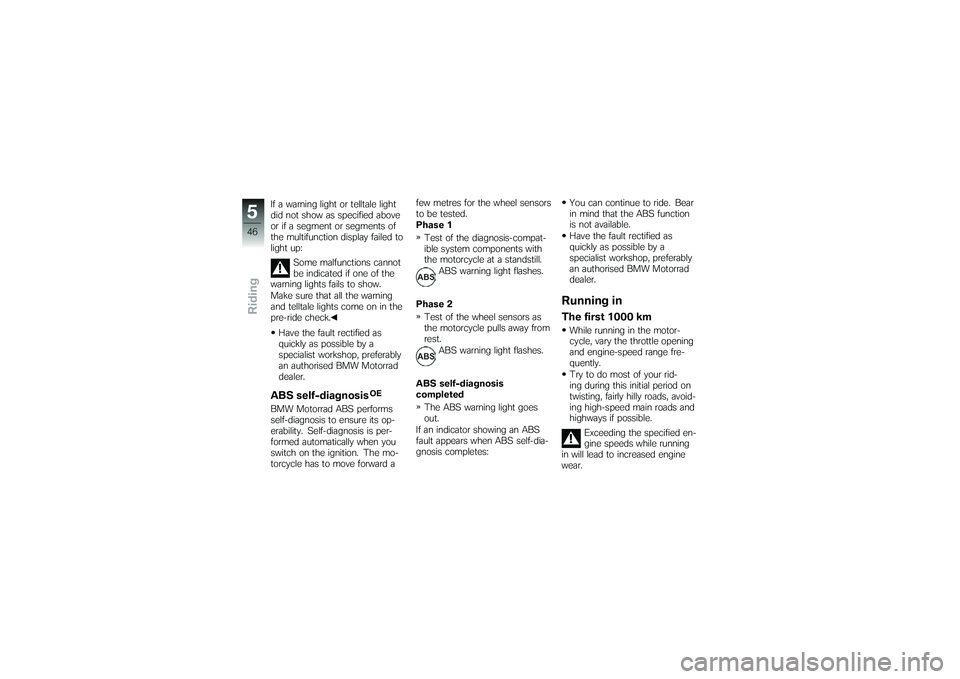
If a warning light or telltale light
did not show as specified above
or if a segment or segments of
the multifunction display failed to
light up:Some malfunctions cannot
be indicated if one of the
warning lights fails to show.
Make sure that all the warning
and telltale lights come on in the
pre-ride check.
Have the fault rectified as
quickly as possible by a
specialist workshop, preferably
an authorised BMW Motorrad
dealer.ABS self-diagnosis
OE
BMW Motorrad ABS performs
self-diagnosis to ensure its op-
erability. Self-diagnosis is per-
formed automatically when you
switch on the ignition. The mo-
torcycle has to move forward a few metres for the wheel sensors
to be tested.
Phase 1
Test of the diagnosis-compat-
ible system components with
the motorcycle at a standstill. ABS warning light flashes.
Phase 2 Test of the wheel sensors as
the motorcycle pulls away from
rest. ABS warning light flashes.
ABS self-diagnosis
completed The ABS warning light goes
out.
If an indicator showing an ABS
fault appears when ABS self-dia-
gnosis completes: You can continue to ride. Bear
in mind that the ABS function
is not available.
Have the fault rectified as
quickly as possible by a
specialist workshop, preferably
an authorised BMW Motorrad
dealer.
Running inThe first 1000 kmWhile running in the motor-
cycle, vary the throttle opening
and engine-speed range fre-
quently.
Try to do most of your rid-
ing during this initial period on
twisting, fairly hilly roads, avoid-
ing high-speed main roads and
highways if possible.
Exceeding the specified en-
gine speeds while running
in will lead to increased engine
wear.
546zRiding
Page 49 of 132
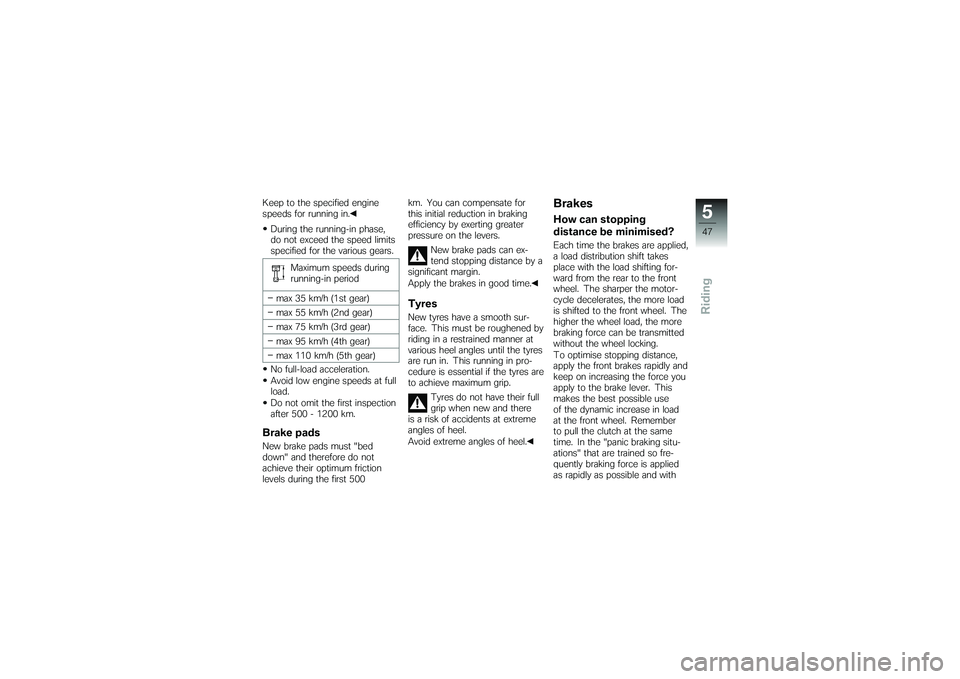
Keep to the specified engine
speeds for running in.During the running-in phase,
do not exceed the speed limits
specified for the various gears.
Maximum speeds during
running-in period
max 35 km/h (1st gear)
max 55 km/h (2nd gear)
max 75 km/h (3rd gear)
max 95 km/h (4th gear)
max 110 km/h (5th gear)
No full-load acceleration.
Avoid low engine speeds at full
load.
Do not omit the first inspection
after 500 - 1200 km.Brake padsNew brake pads must "bed
down" and therefore do not
achieve their optimum friction
levels during the first 500 km. You can compensate for
this initial reduction in braking
efficiency by exerting greater
pressure on the levers.
New brake pads can ex-
tend stopping distance by a
significant margin.
Apply the brakes in good time.
TyresNew tyres have a smooth sur-
face. This must be roughened by
riding in a restrained manner at
various heel angles until the tyres
are run in. This running in pro-
cedure is essential if the tyres are
to achieve maximum grip.
Tyres do not have their full
grip when new and there
is a risk of accidents at extreme
angles of heel.
Avoid extreme angles of heel.
BrakesHow can stopping
distance be minimised?Each time the brakes are applied,
a load distribution shift takes
place with the load shifting for-
ward from the rear to the front
wheel. The sharper the motor-
cycle decelerates, the more load
is shifted to the front wheel. The
higher the wheel load, the more
braking force can be transmitted
without the wheel locking.
To optimise stopping distance,
apply the front brakes rapidly and
keep on increasing the force you
apply to the brake lever. This
makes the best possible use
of the dynamic increase in load
at the front wheel. Remember
to pull the clutch at the same
time. In the "panic braking situ-
ations" that are trained so fre-
quently braking force is applied
as rapidly as possible and with
547zRiding
Page 50 of 132
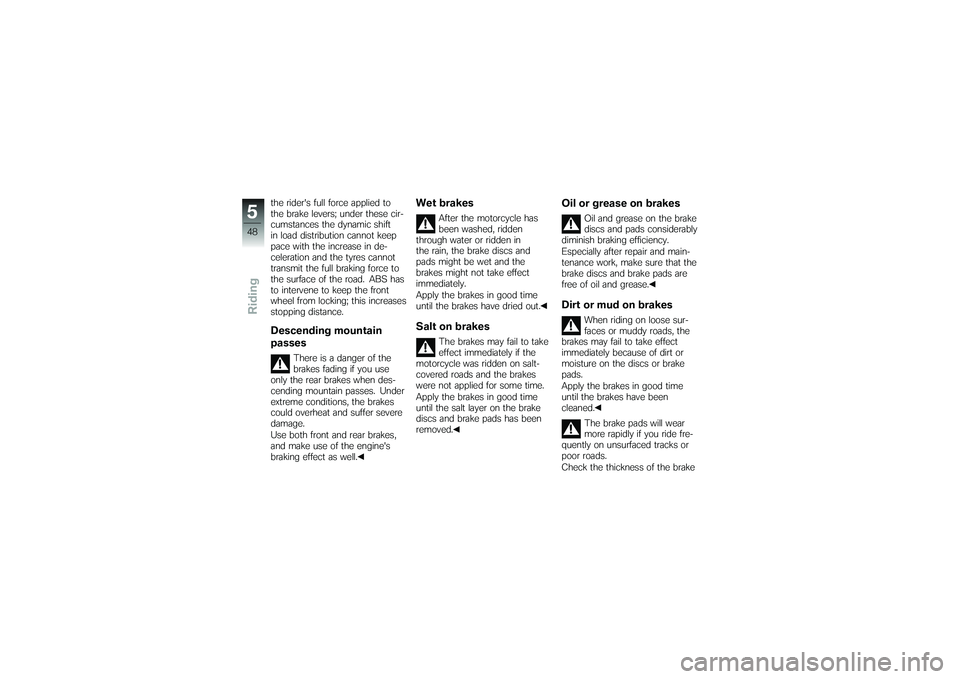
the rider's full force applied to
the brake levers; under these cir-
cumstances the dynamic shift
in load distribution cannot keep
pace with the increase in de-
celeration and the tyres cannot
transmit the full braking force to
the surface of the road. ABS has
to intervene to keep the front
wheel from locking; this increases
stopping distance.Descending mountain
passes
There is a danger of the
brakes fading if you use
only the rear brakes when des-
cending mountain passes. Under
extreme conditions, the brakes
could overheat and suffer severe
damage.
Use both front and rear brakes,
and make use of the engine's
braking effect as well.
Wet brakes
After the motorcycle has
been washed, ridden
through water or ridden in
the rain, the brake discs and
pads might be wet and the
brakes might not take effect
immediately.
Apply the brakes in good time
until the brakes have dried out.
Salt on brakes
The brakes may fail to take
effect immediately if the
motorcycle was ridden on salt-
covered roads and the brakes
were not applied for some time.
Apply the brakes in good time
until the salt layer on the brake
discs and brake pads has been
removed.
Oil or grease on brakes
Oil and grease on the brake
discs and pads considerably
diminish braking efficiency.
Especially after repair and main-
tenance work, make sure that the
brake discs and brake pads are
free of oil and grease.
Dirt or mud on brakes
When riding on loose sur-
faces or muddy roads, the
brakes may fail to take effect
immediately because of dirt or
moisture on the discs or brake
pads.
Apply the brakes in good time
until the brakes have been
cleaned.
The brake pads will wear
more rapidly if you ride fre-
quently on unsurfaced tracks or
poor roads.
Check the thickness of the brake
548zRiding
Page 54 of 132
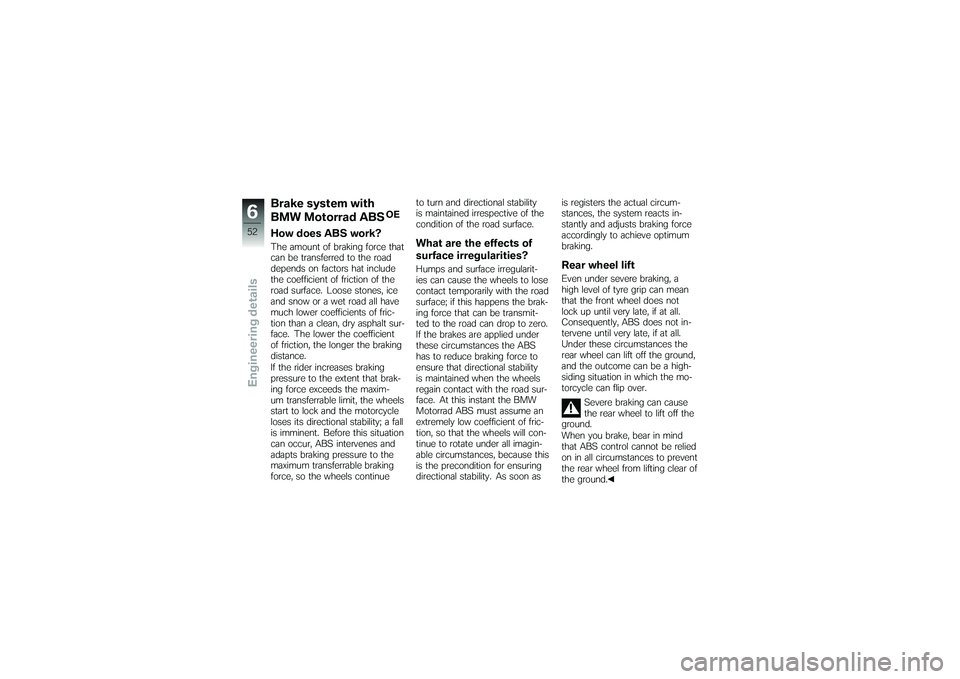
Brake system with
BMW Motorrad ABS
OE
How does ABS work?The amount of braking force that
can be transferred to the road
depends on factors hat include
the coefficient of friction of the
road surface. Loose stones, ice
and snow or a wet road all have
much lower coefficients of fric-
tion than a clean, dry asphalt sur-
face. The lower the coefficient
of friction, the longer the braking
distance.
If the rider increases braking
pressure to the extent that brak-
ing force exceeds the maxim-
um transferrable limit, the wheels
start to lock and the motorcycle
loses its directional stability; a fall
is imminent. Before this situation
can occur, ABS intervenes and
adapts braking pressure to the
maximum transferrable braking
force, so the wheels continueto turn and directional stability
is maintained irrespective of the
condition of the road surface.
What are the effects of
surface irregularities?Humps and surface irregularit-
ies can cause the wheels to lose
contact temporarily with the road
surface; if this happens the brak-
ing force that can be transmit-
ted to the road can drop to zero.
If the brakes are applied under
these circumstances the ABS
has to reduce braking force to
ensure that directional stability
is maintained when the wheels
regain contact with the road sur-
face. At this instant the BMW
Motorrad ABS must assume an
extremely low coefficient of fric-
tion, so that the wheels will con-
tinue to rotate under all imagin-
able circumstances, because this
is the precondition for ensuring
directional stability. As soon as
is registers the actual circum-
stances, the system reacts in-
stantly and adjusts braking force
accordingly to achieve optimum
braking.
Rear wheel liftEven under severe braking, a
high level of tyre grip can mean
that the front wheel does not
lock up until very late, if at all.
Consequently, ABS does not in-
tervene until very late, if at all.
Under these circumstances the
rear wheel can lift off the ground,
and the outcome can be a high-
siding situation in which the mo-
torcycle can flip over.
Severe braking can cause
the rear wheel to lift off the
ground.
When you brake, bear in mind
that ABS control cannot be relied
on in all circumstances to prevent
the rear wheel from lifting clear of
the ground.
652zEngineering details
Page 55 of 132
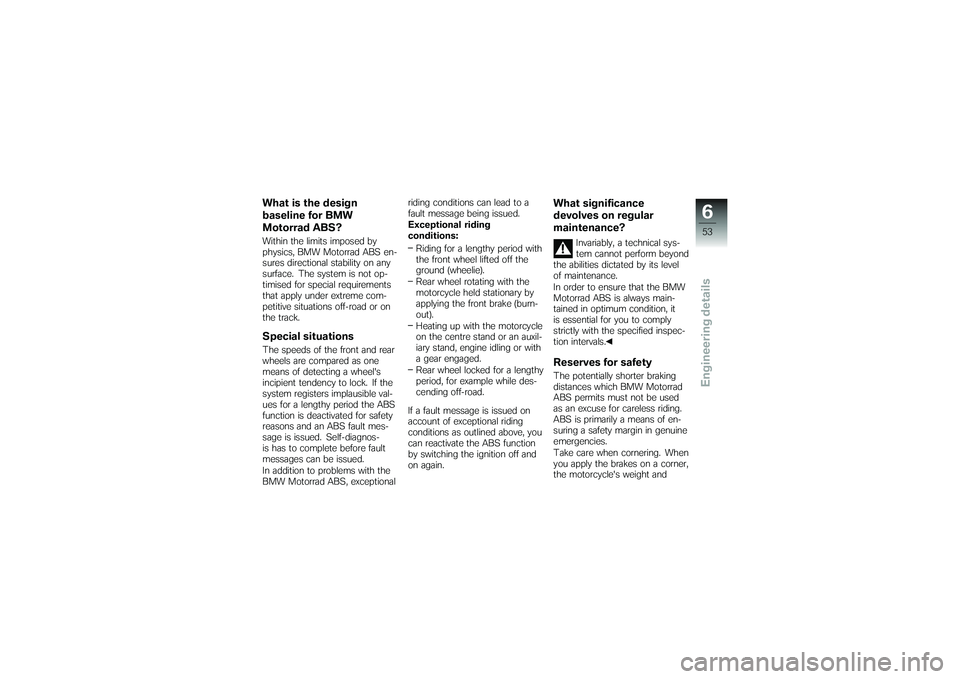
What is the design
baseline for BMW
Motorrad ABS?Within the limits imposed by
physics, BMW Motorrad ABS en-
sures directional stability on any
surface. The system is not op-
timised for special requirements
that apply under extreme com-
petitive situations off-road or on
the track.Special situationsThe speeds of the front and rear
wheels are compared as one
means of detecting a wheel's
incipient tendency to lock. If the
system registers implausible val-
ues for a lengthy period the ABS
function is deactivated for safety
reasons and an ABS fault mes-
sage is issued. Self-diagnos-
is has to complete before fault
messages can be issued.
In addition to problems with the
BMW Motorrad ABS, exceptionalriding conditions can lead to a
fault message being issued.
Exceptional riding
conditions:
Riding for a lengthy period with
the front wheel lifted off the
ground (wheelie).
Rear wheel rotating with the
motorcycle held stationary by
applying the front brake (burn-
out).
Heating up with the motorcycle
on the centre stand or an auxil-
iary stand, engine idling or with
a gear engaged.
Rear wheel locked for a lengthy
period, for example while des-
cending off-road.
If a fault message is issued on
account of exceptional riding
conditions as outlined above, you
can reactivate the ABS function
by switching the ignition off and
on again.
What significance
devolves on regular
maintenance?
Invariably, a technical sys-
tem cannot perform beyond
the abilities dictated by its level
of maintenance.
In order to ensure that the BMW
Motorrad ABS is always main-
tained in optimum condition, it
is essential for you to comply
strictly with the specified inspec-
tion intervals.
Reserves for safetyThe potentially shorter braking
distances which BMW Motorrad
ABS permits must not be used
as an excuse for careless riding.
ABS is primarily a means of en-
suring a safety margin in genuine
emergencies.
Take care when cornering. When
you apply the brakes on a corner,
the motorcycle's weight and
653zEngineering details
Page 61 of 132
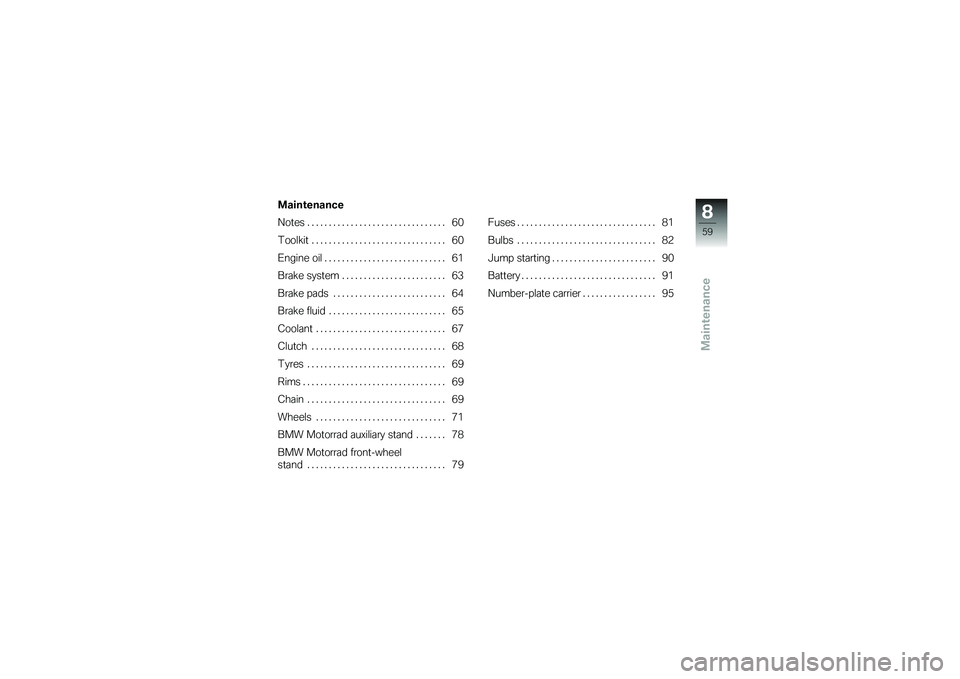
Maintenance
Maintenance
Notes................................ 60
Toolkit . . . ............................ 60
Engine oil ............................ 61
Brake system . ....................... 63
Brake pads . . . ....................... 64
Brake fluid ........................... 65
Coolant . . ............................ 67
Clutch . . . ............................ 68
Tyres ................................ 69
Rims ................................. 69
Chain ................................ 69
Wheels . . ............................ 71
BMW Motorrad auxiliary stand ....... 78
BMW Motorrad front-wheel
stand ................................ 79 Fuses . . .
............................. 81
Bulbs . . . ............................. 82
Jump starting . ....................... 90
Battery . . ............................. 91
Number-plate carrier ................. 95
859zMaintenance
Page 63 of 132
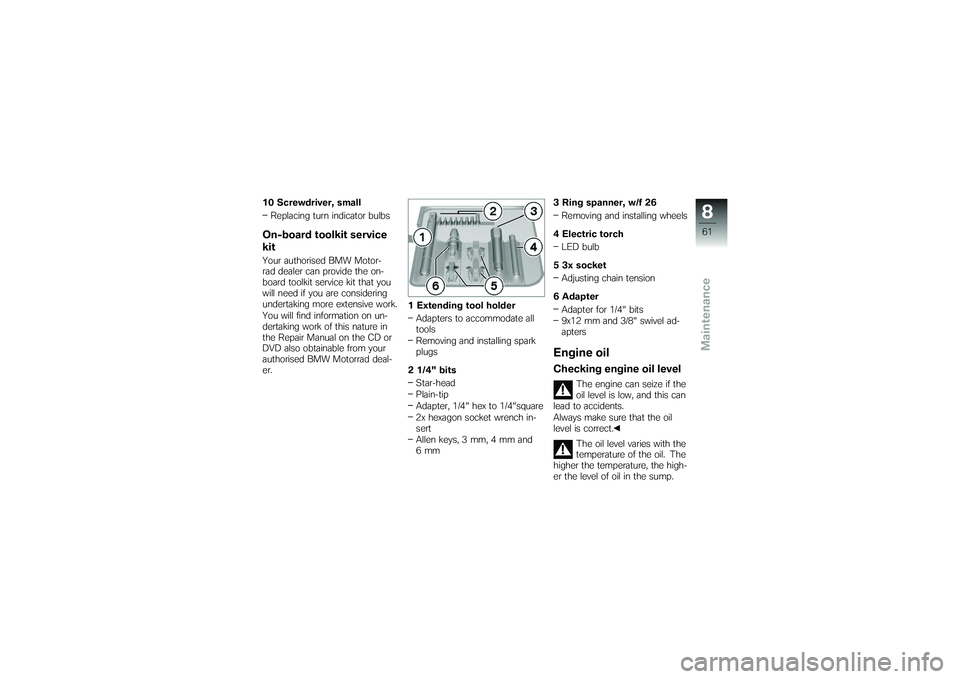
10 Screwdriver, smallReplacing turn indicator bulbsOn-board toolkit service
kitYour authorised BMW Motor-
rad dealer can provide the on-
board toolkit service kit that you
will need if you are considering
undertaking more extensive work.
You will find information on un-
dertaking work of this nature in
the Repair Manual on the CD or
DVD also obtainable from your
authorised BMW Motorrad deal-
er. 1 Extending tool holder
Adapters to accommodate all
tools
Removing and installing spark
plugs
2 1/4" bits Star-head
Plain-tip
Adapter, 1/4" hex to 1/4"square
2x hexagon socket wrench in-
sert
Allen keys, 3 mm, 4 mm and
6mm 3 Ring spanner, w/f 26
Removing and installing wheels
4 Electric torch LED bulb
5 3x socket Adjusting chain tension
6 Adapter Adapter for 1/4" bits
9x12 mm and 3/8" swivel ad-
apters
Engine oilChecking engine oil level
The engine can seize if the
oil level is low, and this can
lead to accidents.
Always make sure that the oil
level is correct.
The oil level varies with the
temperature of the oil. The
higher the temperature, the high-
er the level of oil in the sump.
861zMaintenance
Page 66 of 132
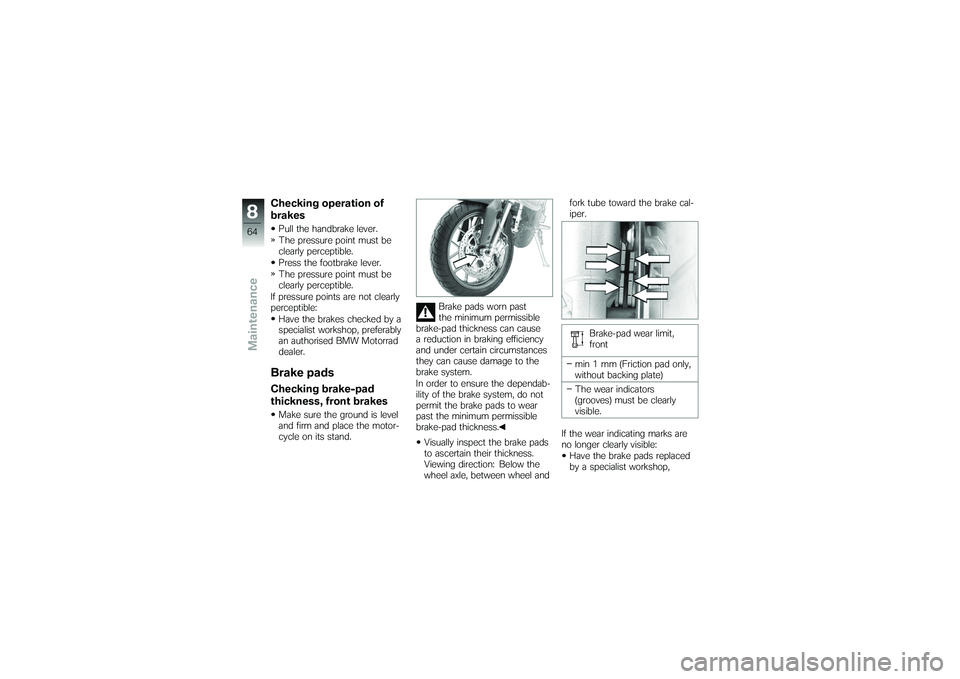
Checking operation of
brakesPull the handbrake lever.
The pressure point must be
clearly perceptible.
Press the footbrake lever.
The pressure point must be
clearly perceptible.
If pressure points are not clearly
perceptible: Have the brakes checked by a
specialist workshop, preferably
an authorised BMW Motorrad
dealer.Brake padsChecking brake-pad
thickness, front brakesMake sure the ground is level
and firm and place the motor-
cycle on its stand. Brake pads worn past
the minimum permissible
brake-pad thickness can cause
a reduction in braking efficiency
and under certain circumstances
they can cause damage to the
brake system.
In order to ensure the dependab-
ility of the brake system, do not
permit the brake pads to wear
past the minimum permissible
brake-pad thickness.
Visually inspect the brake pads
to ascertain their thickness.
Viewing direction: Below the
wheel axle, between wheel and fork tube toward the brake cal-
iper.
Brake-pad wear limit,
front
min 1 mm (Friction pad only,
without backing plate)
The wear indicators
(grooves) must be clearly
visible.
If the wear indicating marks are
no longer clearly visible: Have the brake pads replaced
by a specialist workshop,
864zMaintenance